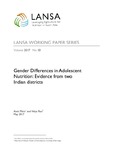| dc.contributor.author | Mitra, Amit | |
| dc.contributor.author | Rao, Nitya | |
| dc.coverage.spatial | India | en |
| dc.date.accessioned | 2018-01-15T13:42:02Z | |
| dc.date.available | 2018-01-15T13:42:02Z | |
| dc.date.issued | 2017-05 | |
| dc.identifier.citation | Mitra, A. and Rao, N. (2017) Gender Differences in Adolescent Nutrition: Evidence from two Indian districts, LANSA Working Paper Vol 2017 No 13. Brighton. IDS | en |
| dc.identifier.uri | https://opendocs.ids.ac.uk/opendocs/handle/20.500.12413/13467 | |
| dc.description.abstract | India is going through a silent crisis as millions of adolescents and adults, both male and female, across the country and over generations face the burden of undernutrition. India’s score in the Global Hunger Index (GHI) computed by the International Food Policy Research Institute (IFPRI) was 28.5 in 2016. While this has improved from 36 in 2008, it still falls in the “serious” category. India ranked 97th out of 118 countries in 2016. Using quantitative data from a one-time survey followed by ethnographic research in two sites in India (Koraput district in Odisha and Wardha district in Maharashtra), this paper seeks to examine the conundrum of gender differentials in adolescent nutrition. While large-scale datasets, as from the National Institute of Nutrition (NIN), suggest that adolescent boys are slightly more undernourished than girls, micro-studies often contradict this finding. In this paper, the authors explore the possible explanatory factors for this divergence, located in household histories in specific agro-ecological settings. Analysis reveals that behind every malnourished child, there is (in general) a history of undernourishment, including an impoverished household. The disadvantage is multiplied by the presence of a malnourished mother (sometimes a malnourished father), medical neglect, water scarcity and often a son preference that leads to the birth of several daughters before a son is born. While acknowledging the importance of child malnutrition as a focus of development policy, the paper concludes with a need to pay attention to adolescents, both boys and girls, in order to ensure well-being in adult life. | en |
| dc.description.sponsorship | DFID | en |
| dc.description.sponsorship | UKAID | en |
| dc.language.iso | en | en |
| dc.publisher | Leveraging Agriculture for Nutrition in South Asia (LANSA) | en |
| dc.relation.ispartofseries | LANSA Working Paper Series 2017;13 | |
| dc.rights.uri | http://creativecommons.org/licenses/by-nc-nd/4.0/ | en |
| dc.subject | Children and Youth | en |
| dc.subject | Gender | en |
| dc.subject | Nutrition | en |
| dc.title | Gender Differences in Adolescent Nutrition: Evidence from two Indian districts | en |
| dc.type | Series paper (non-IDS) | en |
| dc.rights.holder | Leveraging Agriculture for Nutrition in South Asia (LANSA) | en |
| rioxxterms.funder | Default funder | en |
| rioxxterms.identifier.project | Default project | en |
| rioxxterms.version | NA | en |
| rioxxterms.funder.project | 9ce4e4dc-26e9-4d78-96e9-15e4dcac0642 | en |


